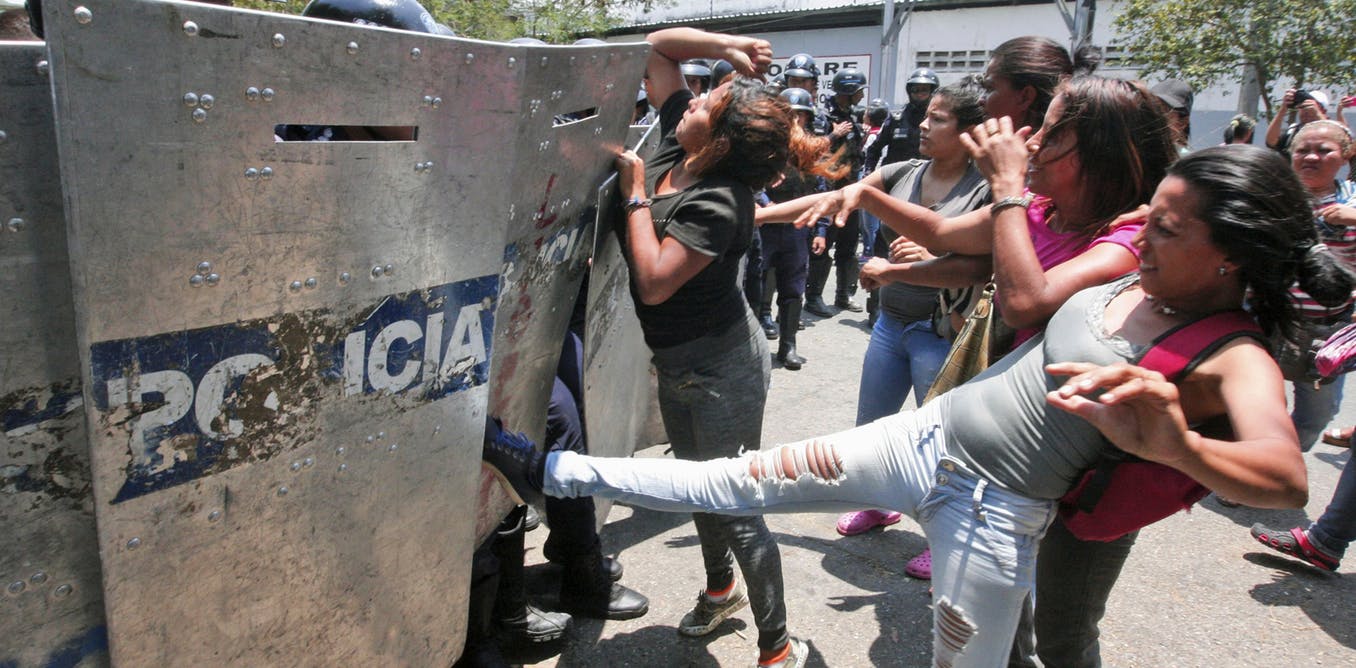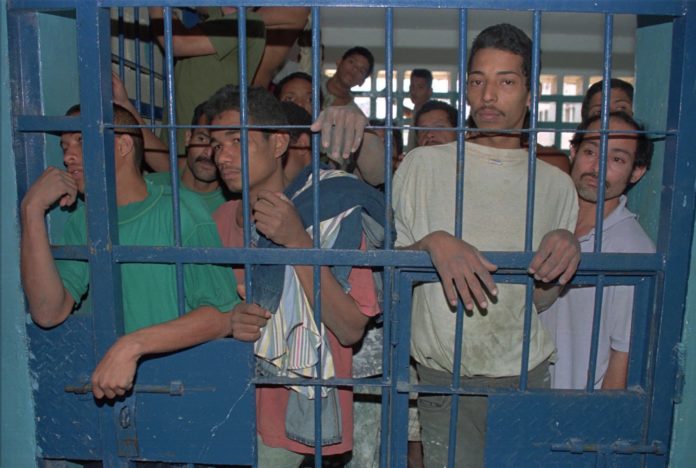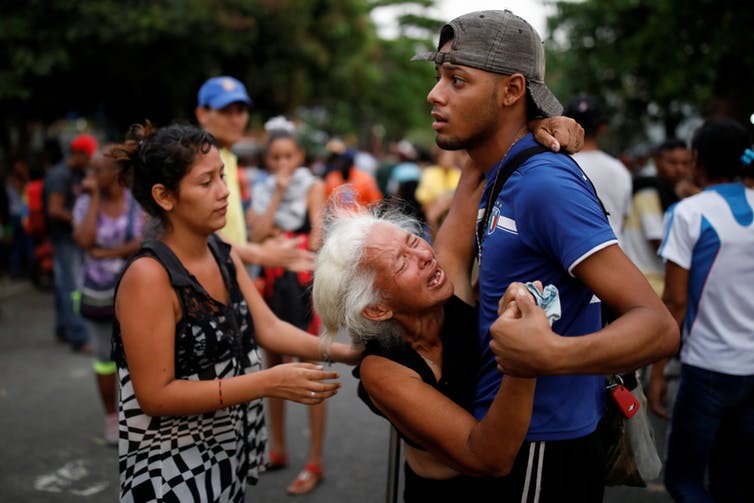Behind the scenes of Venezuela’s deadly prison fire
Rebecca
Hanson & Leonard Gómez Núñez, The Conversation, April 4, 2018
Hanson & Leonard Gómez Núñez, The Conversation, April 4, 2018
A fire
killed scores of
inmates after a riot in a Venezuelan jail in the early morning hours
of March 28. Sixty-six detainees died in the flames, as did two female
visitors.
killed scores of
inmates after a riot in a Venezuelan jail in the early morning hours
of March 28. Sixty-six detainees died in the flames, as did two female
visitors.
 |
| Families clashed with security forces outside the police station in Valencia, Venezuela, where nearly 70 prisoners died in a March 28 fire. AP Photo/Juan Carlos Hernandez |
The
incident was horrifying, but it was not a surprise for those familiar with the
state of the country’s prison system.
incident was horrifying, but it was not a surprise for those familiar with the
state of the country’s prison system.
Prison violence
has long been common in Venezuela. In 1992 at least 63 inmates were killed in
the Retén de Catia prison, which was later demolished after Pope John Paul II
visited and called for
more humane living conditions. In 1994, 108 people died in a
jailhouse riot in the state of
Zulia. And in 1996, 29 inmates were burned alive when the National
Guard set fire to La Planta prison in Caracas.
has long been common in Venezuela. In 1992 at least 63 inmates were killed in
the Retén de Catia prison, which was later demolished after Pope John Paul II
visited and called for
more humane living conditions. In 1994, 108 people died in a
jailhouse riot in the state of
Zulia. And in 1996, 29 inmates were burned alive when the National
Guard set fire to La Planta prison in Caracas.
Between
2012 and 2017 alone, 135 people were killed in four different prison riots
across Venezuela.
2012 and 2017 alone, 135 people were killed in four different prison riots
across Venezuela.
Last
month’s deadly fire is yet another tragedy. But it also differs from past
incidents in critical ways.
month’s deadly fire is yet another tragedy. But it also differs from past
incidents in critical ways.
Much of
the media coverage of the incident, both inside and outside of Venezuela, portrays the
riot and ensuing fire as the outcome of the chaos and lawlessness that rules
Venezuelan prisons. But our research on the country’s criminal
justice system reveals that the story behind the violence is more complicated.
the media coverage of the incident, both inside and outside of Venezuela, portrays the
riot and ensuing fire as the outcome of the chaos and lawlessness that rules
Venezuelan prisons. But our research on the country’s criminal
justice system reveals that the story behind the violence is more complicated.
Mass
incarceration, Venezuela style
incarceration, Venezuela style
The main
driver behind Venezuela’s rising prison violence is
overcrowding.
driver behind Venezuela’s rising prison violence is
overcrowding.
Incarceration
levels in the country rose dramatically during the 1990s. Under President Hugo
Chávez, who governed Venezuela from 1999 to 2013, this trend accelerated –
despite his progressive rhetoric
about eliminating harsh sentencing.
levels in the country rose dramatically during the 1990s. Under President Hugo
Chávez, who governed Venezuela from 1999 to 2013, this trend accelerated –
despite his progressive rhetoric
about eliminating harsh sentencing.
In 1996, 120 of every
100,000 citizens were behind bars Today, 55,000 people – that’s 159 of
every 100,000 Venezuelans – are in jail.
100,000 citizens were behind bars Today, 55,000 people – that’s 159 of
every 100,000 Venezuelans – are in jail.
The
country’s prison system was designed to hold, at most, 20,000. As a result,
short-term detention centers in police stations have swelled with the
inmate overflow. Violence
has become more frequent systemwide.
country’s prison system was designed to hold, at most, 20,000. As a result,
short-term detention centers in police stations have swelled with the
inmate overflow. Violence
has become more frequent systemwide.
According
to Una Ventana a la Libertad, a Venezuelan prison watchdog group, about 45,000
people are currently locked up in overcrowded, makeshift jails in 500 police
stations nationwide.
to Una Ventana a la Libertad, a Venezuelan prison watchdog group, about 45,000
people are currently locked up in overcrowded, makeshift jails in 500 police
stations nationwide.
That’s
where the deadly March 28 fire broke out: not in a prison but in a Carabobo
State police station, where 200 men were detained.
where the deadly March 28 fire broke out: not in a prison but in a Carabobo
State police station, where 200 men were detained.
Venezuela’s
penal code
mandates that police may only keep people who’ve been arrested in these
“calabozos,” or temporary holding cells, for up to 48 hours. After that,
prisoners must be presented before a judge, who will either release them or
transfer them to a long-term facility like a jail to await trial.
penal code
mandates that police may only keep people who’ve been arrested in these
“calabozos,” or temporary holding cells, for up to 48 hours. After that,
prisoners must be presented before a judge, who will either release them or
transfer them to a long-term facility like a jail to await trial.
In
practice, though, detainees are frequently sent back to police stations before
their court date. Even before the 2015 economic
crisis that has plunged Venezuela into disarray, the wait could be
years. Today, the judicial system moves even more slowly, in part because of problems
transporting prisoners between jail and court.
practice, though, detainees are frequently sent back to police stations before
their court date. Even before the 2015 economic
crisis that has plunged Venezuela into disarray, the wait could be
years. Today, the judicial system moves even more slowly, in part because of problems
transporting prisoners between jail and court.
Fully 50
percent of people incarcerated in Venezuela have been
arrested but not convicted of a crime. That population includes the
66 prisoners who perished in the March 28 fire.
percent of people incarcerated in Venezuela have been
arrested but not convicted of a crime. That population includes the
66 prisoners who perished in the March 28 fire.
 |
| Venezuela’s Reten de Catia prison was shut down after Pope John Paul II criticized the inhumane living conditions on a 1996 visit to the facility. AP Photo/Rodolfo Benitez |
What
happened at Carabobo police station
happened at Carabobo police station
There are
different accounts of how the upheaval at the Carabobo police state began,
depending on the source.
different accounts of how the upheaval at the Carabobo police state began,
depending on the source.
According
to state police, detainees in
the makeshift jail revolted early on March 28, forcing police to
enter the detention area and put down the riot. Prisoners then set their
mattresses on fire, officials say, hoping to escape from the violence.
to state police, detainees in
the makeshift jail revolted early on March 28, forcing police to
enter the detention area and put down the riot. Prisoners then set their
mattresses on fire, officials say, hoping to escape from the violence.
But the
interviews we recently conducted with officials at the Venezuelan attorney
general’s office, national police, the Bello Monte morgue and the Cuerpo de
Investigaciones Científicas, Penales y Criminalísticas – Venezuela’s FBI – tell
a more complicated story.
interviews we recently conducted with officials at the Venezuelan attorney
general’s office, national police, the Bello Monte morgue and the Cuerpo de
Investigaciones Científicas, Penales y Criminalísticas – Venezuela’s FBI – tell
a more complicated story.
These
officials, who wish to remain anonymous because this information is not public
and they fear political retribution, say the deadly riot occurred because the
delicate social order that structures jailhouse life in Venezuela broke down.
officials, who wish to remain anonymous because this information is not public
and they fear political retribution, say the deadly riot occurred because the
delicate social order that structures jailhouse life in Venezuela broke down.
Venezuelan
jails are often portrayed as lawless
places, and it is true that the government long ago
ceded control over many prisons to gang leaders inside them.
jails are often portrayed as lawless
places, and it is true that the government long ago
ceded control over many prisons to gang leaders inside them.
But these
facilities do have a governance structure – it’s just not enforced
by the state. Gang leaders within prisons and detention centers – sometimes
referred to as a “pran” or “pranato” – informally control what goes on inside.
facilities do have a governance structure – it’s just not enforced
by the state. Gang leaders within prisons and detention centers – sometimes
referred to as a “pran” or “pranato” – informally control what goes on inside.
Venezuelan
prison guards and police officers are not only aware of this system – they are complicit in
it. Guards and officers smuggle guns
and drugs into prisons and jails, which gangs use to consolidate their power.
In exchange for facilitating
this informal economy, officials are paid
a “vacuna,” or bribe.
prison guards and police officers are not only aware of this system – they are complicit in
it. Guards and officers smuggle guns
and drugs into prisons and jails, which gangs use to consolidate their power.
In exchange for facilitating
this informal economy, officials are paid
a “vacuna,” or bribe.
The
official police version of events in the Carabobo police station – which is
cited in stories from the BBC,
USA Today,
Reuters
and local media outlets – ignores this symbiotic relationship. So does The New
York Times, which reported that the deadly fire was started after
gangs, who were holding a party in an overcrowded jail, fought with
the guards who tried to break it up.
official police version of events in the Carabobo police station – which is
cited in stories from the BBC,
USA Today,
Reuters
and local media outlets – ignores this symbiotic relationship. So does The New
York Times, which reported that the deadly fire was started after
gangs, who were holding a party in an overcrowded jail, fought with
the guards who tried to break it up.
Orderly
chaos breaks down
chaos breaks down
We asked
our official sources, who agreed to speak without attribution, what really
happened on March 28. Their accounts differ slightly, citing as causes of the
violence both police officers’ anger over unpaid “vacunas” and gang fights over
illicit jailhouse economies.
our official sources, who agreed to speak without attribution, what really
happened on March 28. Their accounts differ slightly, citing as causes of the
violence both police officers’ anger over unpaid “vacunas” and gang fights over
illicit jailhouse economies.
But they
all concur that a breakdown in the illicit relationship between gangs and jail
officials was the catalyst – either direct or indirect – of the violence, not
spontaneous prisoner revolt.
all concur that a breakdown in the illicit relationship between gangs and jail
officials was the catalyst – either direct or indirect – of the violence, not
spontaneous prisoner revolt.
Everyone
we spoke with told us that just before 6 a.m., armed officers entered the
overcrowded detention center. Within a half hour, concerned mothers, responding
to phone calls from detainees who said they were under attack, began arriving
at the station.
we spoke with told us that just before 6 a.m., armed officers entered the
overcrowded detention center. Within a half hour, concerned mothers, responding
to phone calls from detainees who said they were under attack, began arriving
at the station.
The Bello
Monte morgue – the government forensic center in Caracas where the official
autopsies were performed – stated that many of those who died had also been
shot or stabbed before they burned in the fire.
Monte morgue – the government forensic center in Caracas where the official
autopsies were performed – stated that many of those who died had also been
shot or stabbed before they burned in the fire.
 |
| Family members waited for news outside the Carabobo police station for hours as fire consumed the makeshift jail inside. Carlos Garcia Rawlins/Reuters |
At around
6 a.m., police allegedly tried to quell the riot with tear gas. Some mattresses
caught fire, and the blaze spread across the locked holding cells.
6 a.m., police allegedly tried to quell the riot with tear gas. Some mattresses
caught fire, and the blaze spread across the locked holding cells.
Family
members stood outside of the burning police station for hours, listening to
explosions and gunfire until firefighters arrived at about 9:30 a.m. Some would
wait over 24 hours to learn whether their incarcerated son, grandson, cousin or
nephew was a casualty of
the conflict.
members stood outside of the burning police station for hours, listening to
explosions and gunfire until firefighters arrived at about 9:30 a.m. Some would
wait over 24 hours to learn whether their incarcerated son, grandson, cousin or
nephew was a casualty of
the conflict.
On March
31, five Carabobo police officers, including the head of the
police station, were arrested
and accused of unspecified “responsibility for the tragic acts that caused the
death of 68 citizens” in the Carabobo detention center.
31, five Carabobo police officers, including the head of the
police station, were arrested
and accused of unspecified “responsibility for the tragic acts that caused the
death of 68 citizens” in the Carabobo detention center.
But those
who lost their loved ones may never know the whole truth of what happened
behind those bars.
who lost their loved ones may never know the whole truth of what happened
behind those bars.


